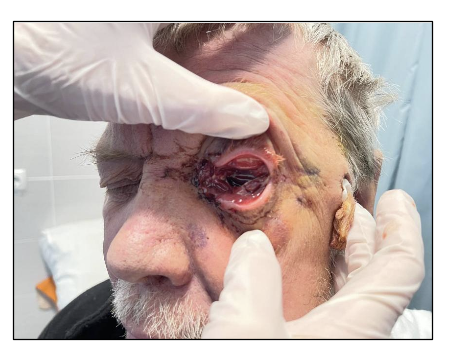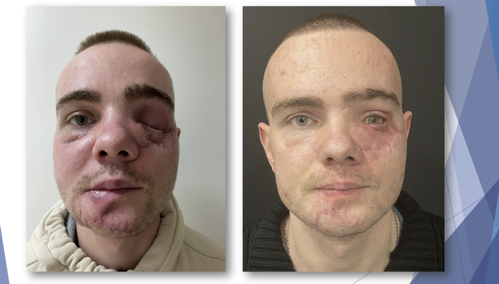Global Ophthalmology, Cataract, Refractive
3D Printing Helps Transform Ukrainian Eye Care
The country’s ophthalmologists offer valuable experience in treating ocular trauma and prosthesis design.

Andrew Sweeney
Published: Wednesday, October 1, 2025
What happens to a country’s healthcare system at war? Lessons learned often lead to innovations discovered. In Ukraine, one of these pearls of wisdom is prostheses development.
The Russian invasion of Ukraine is now in its fourth year, and the war makes for grim reading. Moscow’s casualties are reported to have reached more than 1 million, while Ukrainian dead, wounded, and missing (soldiers and civilians alike) are estimated at around 400,000.
Every aspect of Ukrainian medicine has been affected, including ophthalmology. Since the moment Russian tanks moved across the border, the ESCRS has committed more than €1 million to assist Ukraine’s ophthalmologists, providing direct assistance to 26 clinics and ophthalmic departments across the country.
Yet despite the support of organisations like the ESCRS and international governments, significant challenges remain. Ophthalmologists who faced high patient volumes before the war must now contend with increasingly complex cases.
“The peculiarity of modern combat injuries to the visual organs involves multiplicity of injuries, contusion syndrome, and combined and associated injuries in 85–90% of injuries,” said Oksana Petrenko MD, one of Ukraine’s leading ophthalmic reconstructive surgeons. “These injuries are severe, and bilateral damage to the visual organs occurs in up to 60% of cases.”
Multiple months of trauma
Professor Petrenko’s caseload has increased exponentially since the full-scale war began. Civilians and soldiers alike have come under her care, many suffering from catastrophic ocular injuries and some who were previously denied treatment.
In one case, Prof Petrenko treated a male patient who had suffered the unilateral loss of his left eye (including the eyelid) in Mariupol, a city in eastern Ukraine occupied by Russia after fierce fighting in 2022. He had been shot in the left eye, with the bullet exiting above the left ear. (see image 1)
 Image 1
Image 1
Despite being refused treatment by Russian military personnel, the patient somehow survived these injuries and managed to escape to Ukrainian-held territory after several months. The patient is now healthy, despite suffering serious infections as a result of his ordeal.
“We have seen 320 patients with catastrophic trauma like this patient since February 2022—all involving trauma and maxillofacial eye trauma,” she said. “This has turned us into a multidisciplinary team.”
The most noteworthy aspect of this multidisciplinary approach is the work of Prof Petrenko and her colleagues in creating high-quality prostheses, primarily for those patients who have suffered mine blast injuries. The patient first undergoes a CT scan, the results of which are processed via a 3D printer to create individualised prostheses.
After enucleation or evisceration, an acrylic or silicone conformer is placed in the conjunctival fornix to maintain the conjunctival cavity. While this cannot provide sight, the procedure offers “cosmetic rehabilitation in patients afflicted with psychological problems, which disrupts their social adaptation,” according to Prof Petrenko.
“It is important to form a movable stump with sufficient volume to ensure their medical and psychological rehabilitation. The ocular prosthesis not only eliminates the cosmetic defect but also protects the cavity, maintains its shape, and ensures the correct positioning of the eyelids.”
Giving back quality of life
One case Prof Petrenko was keen to highlight involved a soldier who had sustained catastrophic injuries from a mine blast and shrapnel, resulting in the destruction of the left eye and a shattered zygomatic bone. He was fitted with a specially designed implant and prosthesis and with a supporting titanium plate on the bone—all generated from a CT scan and then 3D printed. (see image 2)

In another case, this time involving catastrophic bilateral damage, Prof Petrenko’s team performed four operations to repair conjunctival and eyelid tissue, allowing them to affix two prostheses. One of them, in the patient’s right eye, was placed directly into the orbital wall using implanted magnets.
“After we place the orbital implant, we suture everything in place, including the sclera and conjunctival membrane. In three to four weeks, if the patient hasn’t experienced any infection, swelling, etc., we can affix the prosthesis,” Prof Petrenko said.
“The results are good because the patient can socialise, and people won’t be nervous around him. It’s hard to communicate if you don’t appear to have eyes.”
The value Prof Petrenko’s work provides is clear, yet her team faces serious funding problems. They’re currently forced to pay out of pocket for essential supplies such as eyelid stitches, and they urgently need a microsurgical instrument coagulator.
Their experience with eyelid reconstruction, implantation, and prosthesis manufacturing using 3D printing should prove highly instructional to clinicians wanting to learn the latest developments in combat trauma surgery. With the war showing no sign of ending soon, unfortunately, there will be more patients who provide insight.
“A multidisciplinary approach to patients with anophthalmia provides opportunities for high-tech reconstructive surgery and achieving the maximum functional and cosmetic result. Our government does not have the opportunity to buy all the equipment we need, so support from abroad would be appreciated.”
Oksana Petrenko MD is Professor of the Department of Ophthalmology of the Shupyk National Medical Academy of Postgraduate Education, Kyiv, Ukraine. visionpetrenko@gmail.com